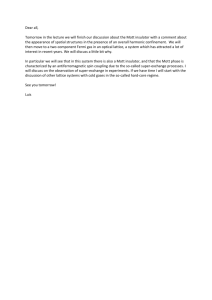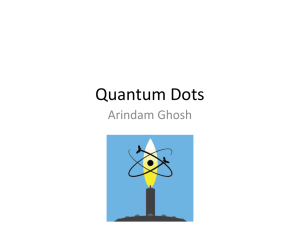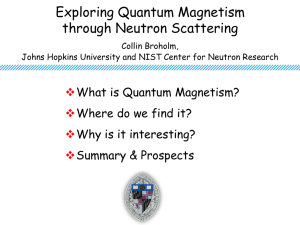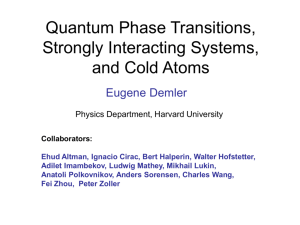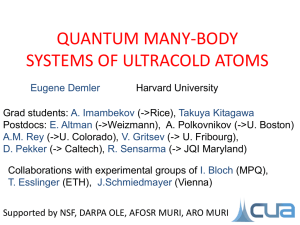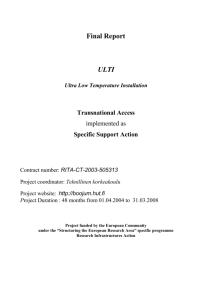Atoms in Latices 1
advertisement
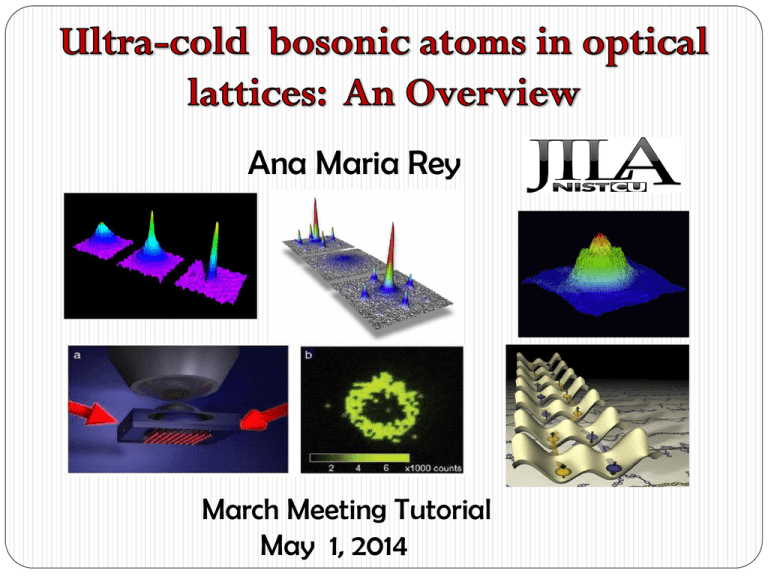
Ana Maria Rey March Meeting Tutorial May 1, 2014 • Brief overview of Bose Einstein condensation in dilute ultracold gases • What do we mean by quantum simulations and why are ultra cold gases useful • The Bose Hubbard model and the superfluid to Mott insulator quantum phase transition • Exploring quantum magnetisms with ultra-cold bosons High temperature T: Thermal velocity v Density d-3 “billiard balls” Low temperature T: De Broglie wavelength lDB=h/mv~T-1/2 “Wave packets” T=Tcrit : Bose Einstein Condensation De Broglie wavelength lDB=d “Matter wave overlap” T=0 : Pure Bose Condensate “Giant matter wave ” Ketterle In 1995 (70 years after Einstein’s prediction) teams in Colorado and Massachusetts achieved BEC in super-cold gas.This feat earned those scientists the 2001 Nobel Prize in physics. S. Bose, 1924 Light A. Einstein, 1925 Atoms E. Cornell C. Wieman Using Rb and W. Ketterle Na atoms • A BEC opened the possibility of studying quantum phenomena on a macroscopic scale. a : Scattering Length s • Ultra cold gases are dilute n: Density Eint . a n * n1 / 3 1 2 s 2 / 3 ma s n Ekin 2m* Cold gases have almost 100% condensate fraction: allow for mean field description How can increase interactions in cold atom systems? 1. increase as: Using Feshbach resonances 2. Increase the effective mass m m* One way to achieve 2. is with an optical lattice Periodic light shift potentials for atoms created by the interference of multiple laser beams. |e |g hn Two counter-propagating beams ~ d Standing wave 2 ~Intensity 4 o V ( x) Sin2 (kx) 4 2 a=l/2 Perfect Crystals AMO Physics • Precision Spectroscopy • Polar Molecules • Scattering Physics e.g. Feshbach resonances Quantum Simulators • Bose Hubbard and Hubbard models Quantum Information • Quantum gates • Quantum magnetism • Robust entanglement generation • Many-body dynamics • Reduce Decoherence Single particle in an Optical lattice Solved by Bloch Waves q: Quasi-momentum –k/2≤ |q| ≤ k/2 n: Band Index k=2 p/a Reciprocal lattice vector Recoil Energy: ћ2k2/(2m) k 2 k k 2 2 k k 2 2 Effective mass d E m 2 dq 2 * 2 1 m* grows with lattice depth k 2 Single particle in an Optical lattice Bloch Functions V=0 V=4 Er Wannier Functions localized wave functions: V=0.5 Er V=20 Er We start with the Schrodinger Equation 2 2 2 Vo sin [kx] V ( x) ( x) i ( x) 2 t 2m x And expand Y in lowest band Wannier states Y i w0 ( x xi ) i Assuming: Lowest band, Nearest neighbor hopping i j J ( j 1 j 1 ) V ( x j ) j 2 p J dx3 w0 ( x xi ) H sp w0 ( x xi 1 ) exp 4 Vo ER Cosine spectrum If V=0 j Ae iqja E (q) 2 J cos[qa] Band width = 4 J Vortices Quantum Simulation Coherence Weakly interacting Bose Gas Strongly interacting Bose Gas Quantum Information Superflow Non Linear optics M. Greiner Quantum Phase transitions New states of matter Idea: Use one physical system to model the behavior of another with nearly identical mathematical description. Important: Establish the connection between the physical properties of the systems We want to design artificial fully controllable quantum systems and use them to simulate complex quantum, many-body behavior What can we simulate with cold atoms? • Bose Hubbard models Quantum phase transitions • Fermi Hubbard models Cuprates, high temperature superconductors, • Quantum magnetism •… Richard Feynman We start with the full many-body Hamiltonian and expand the field operator Y in Wannier states ˆ aˆ w ( x x ) Y j 0 j j Assuming: Lowest band, Short -range interactions, Nearest neighbor hopping H=-J<i,j> âi† âj + U/2 j âj† â†j âj âj + j (Vj –m)âj† âj Hopping Energy External potential Interaction Energy J w0(x) U j kT ,U , J j+1 V 4pas 2 U 2m dx3 | w0 ( x) |4 J dx3w( xi ) H sp w( xi1 ) D. Jacksh et al, PRL, 81, 3108 (1998) m U M.P.A. Fisher et al., PRB40:546 (1989) n=3 Mott 4 n 1 n=2 Mott Superfluid n=1 2 n=1 0 Mott J U U n J U nJ Superfluid phase Weak interactions Mott insulator phase Strong interactions Superfluid – Mott Insulator Quantum phase transition: Competition between kinetic and interaction Deep potential: U>>J energy Shallow potential: U<<J • Weakly interacting gas Superfluid • Strongly interacting gas Mott insulator Superfluid | SF 1 ˆt N 1 (b0 ) | 0 ( aˆ ti ) N | 0 N! N! i Mott Insulator | MI (aˆ tj ) j n n! |0 • Poissonian Statistics • Atom number Statistics • Condensate order parameter • No condensate order parameter i ˆ ˆ b0 b0 N e • Off diagonal long Range Order lim|i j| aˆ tj aˆi n • Gapless excitations bˆ0 0 • Short Range correlations aˆit aˆ j ij • Energy gap ~ U • Step 1: Use the decoupling approximation • Step 2: Replace it in the Hamiltonian z: # of nearest neighbor sites • Step 3: Compute the energy using as a perturbation parameter and minimize respect to . SF: E(2) < 0 E(2) = 0 Critical point Energy Energy Mott: E(2) >0 Van Oosten et al, PRA 63, 053601 (2001) t=0 Turn off trapping potentials Imaging the expanding atom cloud gives important information about the properties of the cloud at t=0: Spatial distribution after time of flight -> Momentum distribution at t=0 In the lattice at t=0 ( x,0) nei w0 ( x Ri ,0) so | | 2 x j a After time of flight σ(t)= tħ/(mσo) | | ( x, t ) ne w0 ( x, t )e 2 x n( x ) |G|= t th am m ~ n(Q) t i j 0 Q nG , 0 iQR j Superfluid Mott insulator Quantum Phase transition Lattice depth : Laser Intensity Markus Greiner et al. Nature 415, (2002); shallow deep shallow The loss of the interference pattern demonstrates the loss of quantum phase coherence. Optical lattice and parabolic potential m U 4 2 0 mi m0 i 2 nn o=3 Mott 1 no=2 Mott no=1 Superfluid Mott J U ultracold.uchicago.edu Observing the Shell structure S. Foelling et al., PRL 97:060403 (2006) Spatially selective microwave transitions and spin changing collisions G. Campbell et al, Science 313,649 2006 J. Sherson et al : Nature 467, 68 (2010). S. Waseems et al Science, 2010 Also N. Gemelke et al Nature 460, 995 (2009) Why are some materials ferro or anti- ferromagnetic A fundamental question is whether spin-independent interactions e.g. Coulomb fources, can be the origin of the magnetic ordering observed in some materials. • Study role of many-body interactions in quantum systems: Non-interacting electron systems universally exhibit paramagnetism • Useful applications Ferromagnetic RAM Magnetic Heads High Tc Superconductivity Exchange interactions Effective spin-spin interactions can arise due to the interplay between the SPIN-INDEPENDENT forces and EXCHANGE SYMMETRY f2 • Exchange Direct overlap Basic Idea Energy Triplet Singlet f1 Experimental Control of Exchange Interactions M. Anderlini et al. Nature 448, 452 (2007) Spin : |0=|F=1,mF=0 |1=|F=1,mF=-1 Singlet < Triplet Orbitals: Two bands g and e Hex Vex (S1 S2 ) 8pa 2 Vex 2m dx3 | w0 ( x) |2 | w1 ( x) |2 w0 w1 Superimpose two lattices: one with twice the periodicity of the other Adjustable bias and barrier depth by changing laser intensity and phase Experimental Control of Exchange Interactions Prepare a superposition of singlet and triplet Measured spin exchange: using band-mapping techniques and SternGerlach filtering Experimental Control of Exchange Interactions Spin dynamics Super-Exchange Interactions • Spin order can arise even though the wave function overlap is practically zero. Virtual processes Super- Exchange f1 f2 Triplet Singlet Energy E.g. Two electrons in a hydrogen molecule, MnO Mn O P.W. Anderson, Phys. Rev. 79, 350 (1950) Super-exchange in optical lattices Consider a double well with two atoms At zero order in J , the ground state is Mot insulator with one atom per site and all spin configurations are degenerated J lifts the degeneracy: An effective Hamiltonian can be derived using second order perturbation theory via virtual particle hole excitations J J 0, 2J J , U , ,0 Super-exchange in optical lattices For spin independent parameters H eff 2 J ex S R S L - Bosons , + Fermions J ex 2J 2 U Reversing the sign of super-exchange Add a bias: Jex J2 U 2 J2 U 2 J2U U2 42 2>U implies Jex<0 S. Trotzky et. al , Science, 319,295(2008) Two bosons in a Double Well with Sz=0 Only 4 states: Vibrational spacing o>>U,J 2 singly occupied configurations: (1,1) (1,1)|s , (1,1)|t s 1 ( ) 2 Singlet t 1 ( ) 2 Triplet 2 doubly occupied configurations: (2,0)|t , (0,2)| t (0,2)| S (2,0) (0,2) o Energy levels in symmetric DW: o»U Good basis: ( 1,1) t ,s 2 | , 20 02 2 t |s, |- are not coupled by J. They have E=0,U for any J. |t, |+ are coupled by J: Form a 2 level system |++ a|t |- ħ2 ħ1 U |s |t + a’|+ In the U>>J limit ħ1~ 4J2/U: Super-exchange ħ2~ U Magnetic field gradient In the limit U>>J, only the singly occupied states are populated and they form a two level system: |s= | and |t=| A Magnetic field gradient couples | and | B ( BR BL )zˆ J ex H B B 0 • If |B|« Jex then | s and | t • If | B |» Jex are the eigenstates then | ↓↑ and |↑↓ are the eigenstates Experimental Observation S. Trotzky et. al , Science, 319,295(2008) Prepare |↑↓ |B|>0 Turn of B M t Evolve Measure spin imbalance Nz: |s # atoms |↑↓ - # atoms |↓↑ N z( t ) f( 1,2 ) In the limit J<<U, |↑↓ |tz Nz (t ) cos(2Jex t ) Simple Rabi oscillations Measuring Super-exchange Two frequencies V=6Er V=11 Er V=17 Er Almost one frequency Comparisons with B. H. Model 2Jex Shadow regions: 2% experimental lattice uncertainty Extended B. H. Model Real Materials: • Complicated • Disorder Direct experimental test of condensed matter models: Great success and a lot of new challenges ? Condensed matter models: Difficult to calculate Cold atoms in optical lattice: Clean realization of CM models
